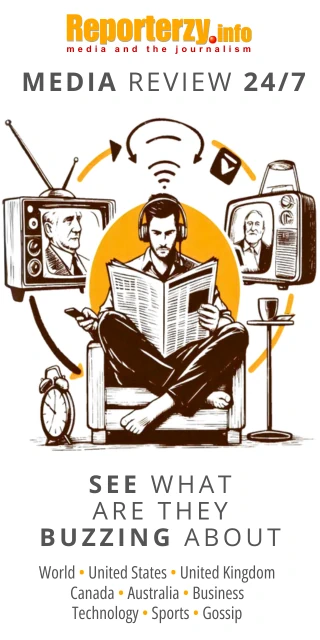 illustration: bing.com/create
illustration: bing.com/createThe data collected in the report shows that these changes are not merely temporary but reflect a long-term trend that could have serious implications for the future of journalism worldwide.
Decreasing Interest in News
One of the report’s most concerning findings is the ongoing decline in interest in news across many countries. For example, in the United Kingdom, interest in news has nearly halved over the past decade - from 70% in 2015 to just 38% in 2024. A similar trend is seen in Argentina, where interest in news dropped from 77% in 2017 to 45% in 2024.
It’s also worth noting that women and young people represent a significant portion of this shift. Among younger generations, a growing number are avoiding traditional news in favor of alternative sources, such as social media. Platforms like TikTok and Instagram, for instance, are becoming primary sources of information for young people, further reducing their interest in traditional forms of journalism.
Decline in Trust in Media
Trust in media has also deteriorated significantly over recent years. In 2024, only 40% of respondents across 47 surveyed countries stated that they trust most news most of the time. By comparison, at the height of the COVID-19 pandemic, this figure was four percentage points higher.
It’s notable that Finland is the only country where interest in news has remained high, an exception to the general downward trend. In other countries, such as Greece and Hungary, trust in media is at its lowest, reaching just 23%.
Examples of Changing Perceptions of Media
The report also highlights the rise in selective news avoidance, with about 39% of respondents saying they sometimes or often avoid news - an increase of three percentage points from the previous year. In some countries, such as Brazil, Spain, Germany, and Finland, this rise is even more pronounced.
Ongoing conflicts, like those in Ukraine and Gaza, may contribute to audience fatigue and a reluctance to follow the news.
The study also indicates that while the public feels well-served with political and sports news, there’s a shortage of coverage on local events, health, and education.
Conclusions
The “Digital News Report 2024” reveals significant challenges facing modern journalism. Decreasing interest in news and declining trust in media are trends that could lead to the further marginalization of traditional forms of journalism if appropriate actions are not taken.
Media organizations must rethink their strategies and find ways to regain trust and engage audiences, particularly among younger generations who are increasingly distancing themselves from traditional media.
The full Digital News Report 2024 can be downloaded for free at:
https://reutersinstitute.politics.ox.ac.uk/digital-news-report/2024
COMMERCIAL BREAK
New articles in section Media industry
Advertising market 2025. Poland, Europe and the World
Marcin Grządka
The global advertising market is growing by 8.8% in 2025 and will reach a value of 1.14 trillion dollars. The industry result in Europe records slightly lower dynamics, at the level of 5.8%. In this comparison, Poland performs clearly above the average. We will record an increase of 8.9% this year and a value of 18.56 billion PLN - estimates WPP Media in the annual report "This Year Next Year".
The print media market 2025. Three global trends
Krzysztof Fiedorek
The market value is 359.53 billion dollars, yet the erosion is visible to the naked eye. The decline for newspapers will amount to -2.3 percent. Despite this, print retains strength: it generates 76 percent of subscription revenues and enjoys 82 percent consumer trust. The future of the industry is defined by hybrid strategies and niche specialization.
Journalism in the age of AI. Why people prefer humans over machines
Krzysztof Fiedorek
Only 12% of people accept news created solely by AI, while 62% prefer those written by humans. At the same time, only 19% notice labels indicating the use of artificial intelligence, while younger audiences ask AI to explain the content to them. These are the findings of the Reuters Institute report on artificial intelligence in media.
See articles on a similar topic:
Digital media addiction. Why the brain can’t cope
KFi
Digital media can hijack the brain's reward system in ways similar to drugs and alcohol, warned psychiatrist and author Anna Lembke. She emphasized that compulsive use of digital platforms can become a serious addiction. Not just a bad habit or risky behavior.
Video Games Drive Europe. Record Number of Players in 2023
BARD
The video game market in Europe reached a value of €25.7 billion in 2023, marking a 5% increase compared to the previous year. Video Games Europe and the European Games Developer Federation released the report "All About Video Games – European Key Facts 2023".
Yellow Press. What is Yellow Journalism?
Krzysztof Fiedorek
The terms "yellow press" and "yellow journalism" are often used pejoratively to describe journalistic practices focused on sensationalism, gossip, and emotions rather than objective facts. Let’s explore their origins, distinctive features, and impact on society.
Radio in Europe. How Are Listener Habits Changing?
KFi
Radio remains one of the most popular media in Europe, but data from the European Broadcasting Union's report "Audience Trends: Radio 2024" shows clear changes in listener habits. The average European spent 2 hours and 13 minutes per day listening to the radio in 2023. This is 18 minutes less than five years ago but only one minute less than the previous year.






























